
Fresh vegetables and beans: the cornerstone of the Mediterranean diet.
Mediterranean cooking techniques are deeply rooted in a culinary tradition that’s not just about tantalizing dishes—it’s a vibrant way of life. As a child, I watched in awe as my grandma and aunts gathered around the kitchen table, delicately carving fresh zucchini and masterfully rolling grape leaves. This was more than just cooking; it was a symphony of love, tradition, and dedication. It was about nurturing the family, where every dish carried a story, a memory. These methods, rooted in sun-kissed produce and the art of slow cooking, have always highlighted the joy of unhurried meals relished with close ones. While Mediterranean cuisine is a harmonious blend of health benefits and fresh ingredients, it also reflects the Mediterranean ethos: a celebration of life’s simple moments, surrounded by laughter and the cherished act of dining together.
Fundamental Techniques in the Mediterranean Kitchen
Mediterranean cooking is as much about the techniques as the ingredients. Start by getting familiar with the basic methods, and once you’re comfortable, feel free to experiment and add your personal touch to bring out the authentic flavors and textures in your kitchen.

Vegetables transformed through the art of slow cooking.
1- Slow Cooking: The Heartbeat of Mediterranean Kitchens
Among the treasured Mediterranean cooking techniques, slow cooking stands out for its emphasis on patience and time. This technique allows the ingredients to blend harmoniously over extended periods, ensuring every bite bursts with flavor and tenderness. Dishes like Braised Lamb Shanks, Slow Roasted Lamb Shoulder, and the Classic Slovenian Beef Goulash are culinary masterpieces, thanks to these traditional Mediterranean cooking techniques. It’s all about letting ingredients mingle and interact, savoring the slow dance of flavors.
Pro Tips for Slow Cooking:
- Consistent Heat: Ensure heat remains low and steady. This maintains the dish’s integrity, preventing burns or overcooking.
- The Right Pot: A heavy-bottomed pot or Dutch oven is a slow cooker’s best friend. It ensures even heat distribution.
- Layer Intentionally: Start with ingredients that require longer cooking times at the bottom, working your way up to quicker cooking ones.
- Harness Fresh Herbs: Herbs like rosemary, thyme, and bay leaves infuse slowly, enriching the dish.
- Give Space: Don’t overcrowd. Ingredients need room to cook evenly and breathe.
- Seal Well: A tight seal retains moisture, especially in ovens, amplifying flavors.
- Embrace Patience: Frequent checking disrupts the cooking process. Trust the time and let the dish bloom.
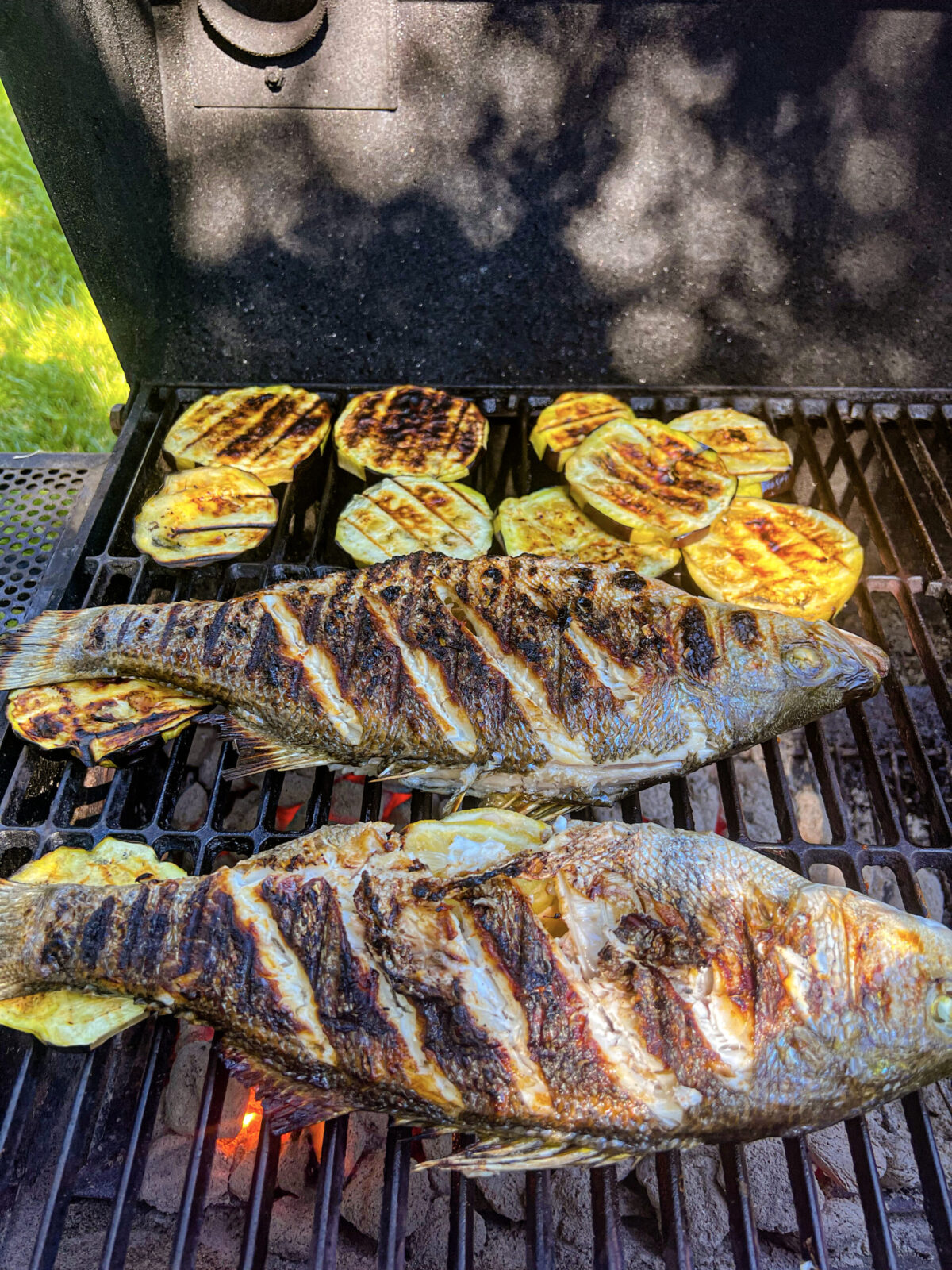
Black Sea Bass, kissed by the grill, Mediterranean-style
2-Grilling and Charring in Mediterranean Cooking Techniques
In the practice of Mediterranean cooking techniques, the smoky allure of charring holds a special place. The rich smokiness that envelopes baba ganoush made from charred eggplant or the vibrant muhammara, with its depth from charred bell peppers, exemplifies this. Another cherished Mediterranean cooking technique is grilling. From Turkish kebabs to Grecian souvlaki, meats grilled over an open fire encapsulate the region’s essence. Beyond meats, grilling simple vegetables using Mediterranean techniques transforms them. Eggplant and zucchini brushed with golden olive oil and grilled to perfection, are imbued with the warmth of the Mediterranean sun.
Pro Tips for Grilling and Charring:
- For a deeper smoky flavor, char vegetables over an open flame. However, a stove or broiling in the oven is perfect for a controlled char.
- Post charring, to easily peel the skin off vegetables, place them in a sealed container or wrap them in foil for about 10 minutes. This steaming process loosens the skin. Always handle with care.
- When grilling vegetables, a brush of olive oil prevents them from drying out and sticking to the grill. It also imparts a wonderful flavor and helps in caramelization, giving them those iconic grill marks.
- Always preheat your grill. A hot grill ensures proper sear marks and helps in even cooking.
- Remember, different vegetables have different cooking times. Denser veggies like bell peppers might take longer than softer ones like zucchini. Adjust your grilling time accordingly.

Chicken cubes are deeply immersed, allowing the marinade to penetrate and infuse every bite.
3- Marinating: Unlocking Flavor and Texture
Marinating, one of the essential Mediterranean cooking techniques, is akin to prepping food with a flavor-packed embrace. It guarantees that meats, such as chicken kabab or oven-roasted chicken with za’atar and sumac, are tender and zesty. When it comes to fish, employing this technique ensures a standout flavor. At its heart, marinating is about immersing ingredients in flavorful liquids, a Mediterranean cooking technique that makes a noticeable difference in your final dish.
Pro Tips for Marinating:
- Time Matters: For most meats, 2-8 hours is ideal. Fish usually need less time, often around 30 minutes to an hour. Marinating too long, especially in acidic mixtures, can make meat mushy.
- Yogurt’s Magic Touch: Many Mediterranean dishes use plain yogurt in their marinades. It not only tenderizes but also adds a mild tang.
- Safe Containers: Opt for glass or plastic containers when marinating. Some metals can interact with acidic ingredients, altering the flavor.
- Temperature Check: While it’s essential to keep marinating food in the fridge for freshness, always bring it to room temperature before cooking. It ensures even cooking.
- Save Some Sauce: Planning to use the marinade later? Reserve some before adding the meat. If you wish to reuse marinade that has had raw meat, ensure it’s boiled first.
- Flavor Soak: Ensure the marinade covers your food thoroughly for perfect taste. Turning it occasionally will help evenly distribute the flavors.
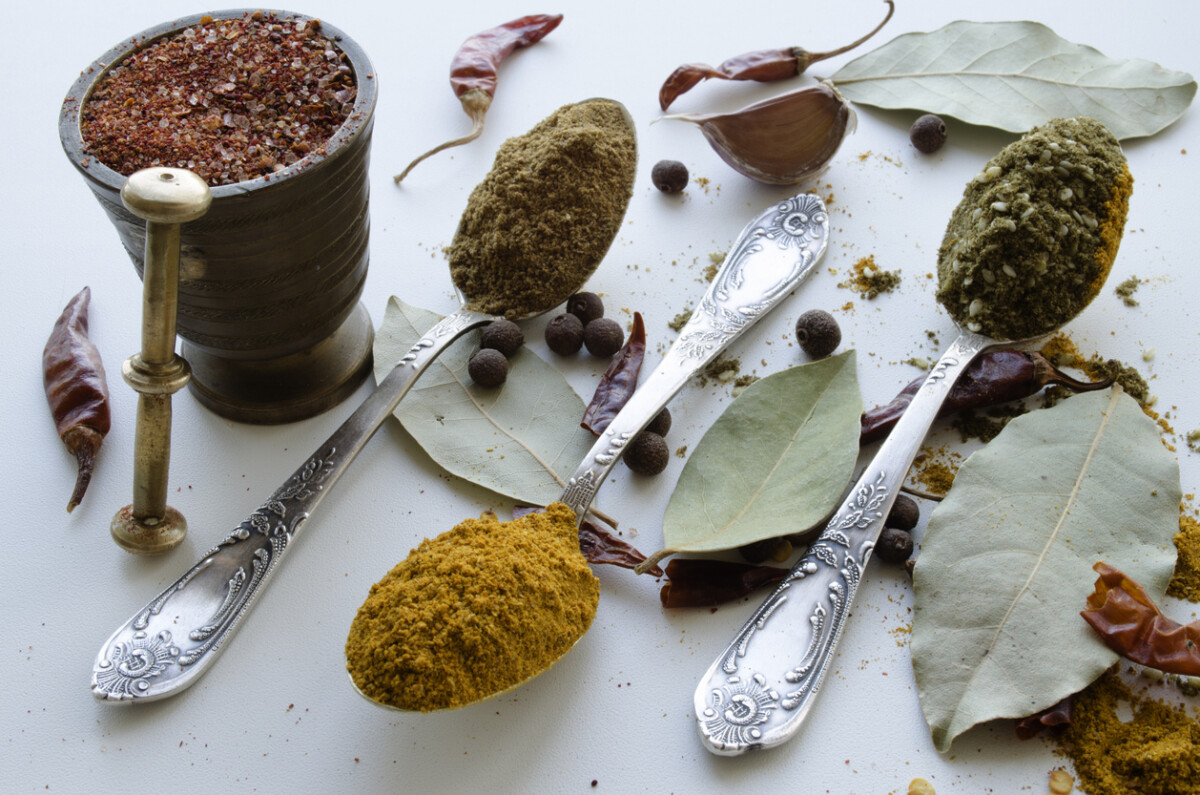
Brass mortar and silver teaspoons showcase the heart of Mediterranean flavors.
4- Seasoning and Sauces in Mediterranean Cooking Techniques:
The Mediterranean kitchen isn’t just about sprinkling salt or grinding pepper. It’s a tapestry of flavors, colors, and fragrances. Each region has its signature seasonings and dishes that bring to life the essence of the Mediterranean.
Regional Breakdown:
Greece: Oregano, lemon zest, dill, and a generous slather of tzatziki, the cool, tangy yogurt-cucumber sauce, define Greek flavors. Classics like moussaka often rely on these foundational seasonings.
Italy: Basil, rosemary, and garlic take center stage. Fresh tomato sauce, crafted from sun-ripened tomatoes simmered with fresh herbs, is the heart of many Italian dishes.
Spain: Pimentón (smoked paprika), saffron, and the irresistible taste of seafood paella is distinctly Spanish. The rich and robust Romesco sauce, made of nuts and red peppers, adds a special touch to many traditional dishes.
Levant: Sumac, za’atar, sesame seeds, and the iconic manakeesh showcase Levantine flavors. The creamy sesame paste, tahini, is foundational to many sauces and dips, including the beloved hummus.
North Africa: North African tastes are synonymous with cumin, coriander, mint, spicy shrimp harissa, and tangy preserved lemons, especially in dishes like chicken tagine.
Pro Tips for spices and herbs:
- Herb Timing: Use dried herbs at the beginning of cooking to allow them to infuse the dish. Fresh herbs are best added in the last stages of cooking or even as a garnish to preserve their vibrant taste and aroma.
- Freshness First: Whenever possible, choose fresh herbs over dried ones. Their vivacity elevates any dish.
- Sauce Secrets: Craft sauces like tomato sauce from scratch using ripe tomatoes for a deeper, fresher taste. It’s an effort that pays in flavor.
- Salt Smartly: While seasonings add depth, be judicious with salt. Continuously taste and adjust, seeking a harmonious balance.
- Experiment and Personalize: The Mediterranean palette is diverse. Once you’ve got the basics down, venture out. Adapt, innovate, and make the flavors uniquely yours.

Showcasing the tradition of pickling in the Mediterranean diet.
5-Preserving and Fermenting: Essential Mediterranean Cooking Techniques
The Mediterranean kitchen resonates deeply with the rhythms of time-honored traditions and Mediterranean cooking techniques. Techniques of fermenting and preserving, cherished through generations, remain central to family kitchens across the region. These methods aren’t just about celebrating a spectrum of flavors; they are a tribute to the changing seasons and the mastery of Mediterranean cooking techniques.
I carry vivid childhood memories of the atmosphere my mother, grandmother, and aunt cultivated in our kitchen. From the gentle bubbles of fermenting yogurt to the aromatic allure of pickled vegetables and the organized lines of preserved jars, each container wasn’t just a product of their hard work but a testament to their mastery of Mediterranean cooking techniques, capturing the essence of every season. Their approach, rooted in these techniques, was uncomplicated and profound: harness nature’s seasonal best and let nothing go to waste.
Why Preserve and Ferment?
Natural Preservation: In an era before refrigeration, these methods were essential. They extended the shelf life of perishables, ensuring a year-round supply of vital ingredients.
Flavor Development: Fermenting and pickling introduce a world of complex flavors. A plain cucumber transforms into a zesty, crunchy delight; whole milk evolves into thick, tangy yogurt.
Health Benefits: Fermented foods are rich in probiotics and can aid digestion. They also boost the immune system and provide essential vitamins.
Pro Tips for preserving food:
- Cleanliness: Sterilize all jars and equipment to prevent harmful bacteria from spoiling your preserves.
- Quality Matters: Always use fresh, high-quality ingredients. If you don’t eat it fresh, don’t preserve it.
- Patience Pays: Whether it’s allowing yogurt to ferment or waiting for pickles to reach that perfect tanginess, patience is essential. Remember, time does most of the work.
- Experiment: While traditional methods have charm, don’t be afraid to add your twist. Maybe a unique spice in your pickles or a different fruit in your jams.
- Safety First: Always follow safe fermentation and preservation methods. When in doubt, consult trusted resources or culinary experts.
With these techniques in your arsenal, you’ll continue a rich culinary legacy and craft memories for the next generation. Remember, every jar you seal captures a moment, a season, and a story.

These three jars are filled to the brim with our nourishing homemade vegetable broth, ready to enhance your favorite recipes.
6- Stocks – The Unsung Heroes of the Mediterranean Kitchen
In the vast world of culinary arts, stocks may seem like a humble backdrop, but they are the foundation of many a sumptuous dish. These clear, flavorful liquids extracted from simmering meats, fish, bones, or vegetables are essential to many of the Mediterranean’s most iconic recipes.
The Essence of Flavor: A stock’s purpose is to capture its ingredients’ essence. The delicate flavors from fish bones and herbs for a bouillabaisse or the robust tones from beef bones – a stock condenses the very soul of its components.
Versatility: Stocks offer incredible flexibility in the kitchen. Once prepared, they can be stored for many uses – from reducing intense flavor to serving as a base for soups or even as a cooking medium for grains.
Waste Not: Stocks exemplify zero waste philosophy, giving new purpose to what might otherwise be considered scraps. Those vegetable peels, fish heads, or poultry bones that might be discarded contribute to a rich and flavorful stock.
Pro Tips to make the healthiest stocks:
- Clarity is Key: A gentle simmer, not a vigorous boil, is essential for a clear stock. This ensures that impurities don’t mix into the stock, ensuring a crystal-clear consistency.
- Skim and Clean: Foam and other impurities will gather at the top during simmering. Skimming these off ensures a pure and refined flavor.
- Cool and Store: Quick cooling is crucial for any stock to remain fresh and free from bacterial growth. Once cooled, portioning and freezing make for easy future use. Ice cube trays can be a great way to freeze stock in handy portions!
For those curious about the nuances between stock and broth or keen on diving deeper into the world of these flavorful liquids, check out my blog. I delve into the differences between ‘Stock and Broth‘ and guide you through recipes for making Chicken, Lamb, and Vegetable Stock. Equip yourself with this culinary secret; even the simplest dishes will shine with depth and flavor.

Harmony in Flavors: Olives, Feta & Honey.
7- Balancing Flavors: The Symphony of Mediterranean Dishes
At the heart of every Mediterranean dish lies a delicate dance of flavors, a testament to the Mediterranean cooking techniques refined over centuries. Whether it’s the tang of a fresh lemon against the deep savory notes of lamb or the bright burst of a cherry tomato playing off creamy feta, achieving this balance makes each bite unforgettable. Mastering these techniques and understanding how to strike this harmony is a fundamental skill in Mediterranean cooking.
Take the timeless Greek salad as an example of these techniques – the salty crumble of feta harmonizes with the sharp bite of olives. At the same time, cucumbers offer a refreshing crunch against juicy tomatoes. It’s not just a salad; it perfectly represents a balanced Mediterranean flavor profile crafted through tried and true Mediterranean cooking techniques.
Tips for Achieving Flavor Balance:
- Taste as You Go: One of the most straightforward yet vital tips. Continually tasting your dish allows you to adjust the seasoning or ingredients gradually, ensuring each element shines without overpowering the others.
- Acid is Your Friend: If a dish feels too heavy or one-dimensional, a splash of vinegar or a squeeze of lemon can brighten it up. Acidity cuts through richness and brings out the natural flavors of other ingredients.
- Use Sweetness Sparingly: Mediterranean dishes often have subtle sweet notes, whether from ripe fruits, honey, or even certain vegetables. Remember, a touch of Sweetness can counteract bitterness or acidity, but it shouldn’t dominate.
- Herbs to the Rescue: Fresh herbs can both intensify and balance flavors. For instance, the freshness of mint can counteract the spiciness of a dish, while rosemary can add depth to milder ingredients.
- Salt Wisely: Salt doesn’t just make things salty. It can amplify other flavors, making them more pronounced. But always be cautious – too much salt can overshadow the natural flavors of your ingredients.
- Understand Bitterness: Some Mediterranean ingredients, like olives, certain greens, or even the famed extra virgin olive oil, have a bitter profile. Embrace but balance it with other flavor profiles to achieve a well-rounded dish.
Balancing flavors is both an art and a science. With practice, intuition kicks in, and you’ll find yourself effortlessly creating dishes where every ingredient sings in perfect harmony.
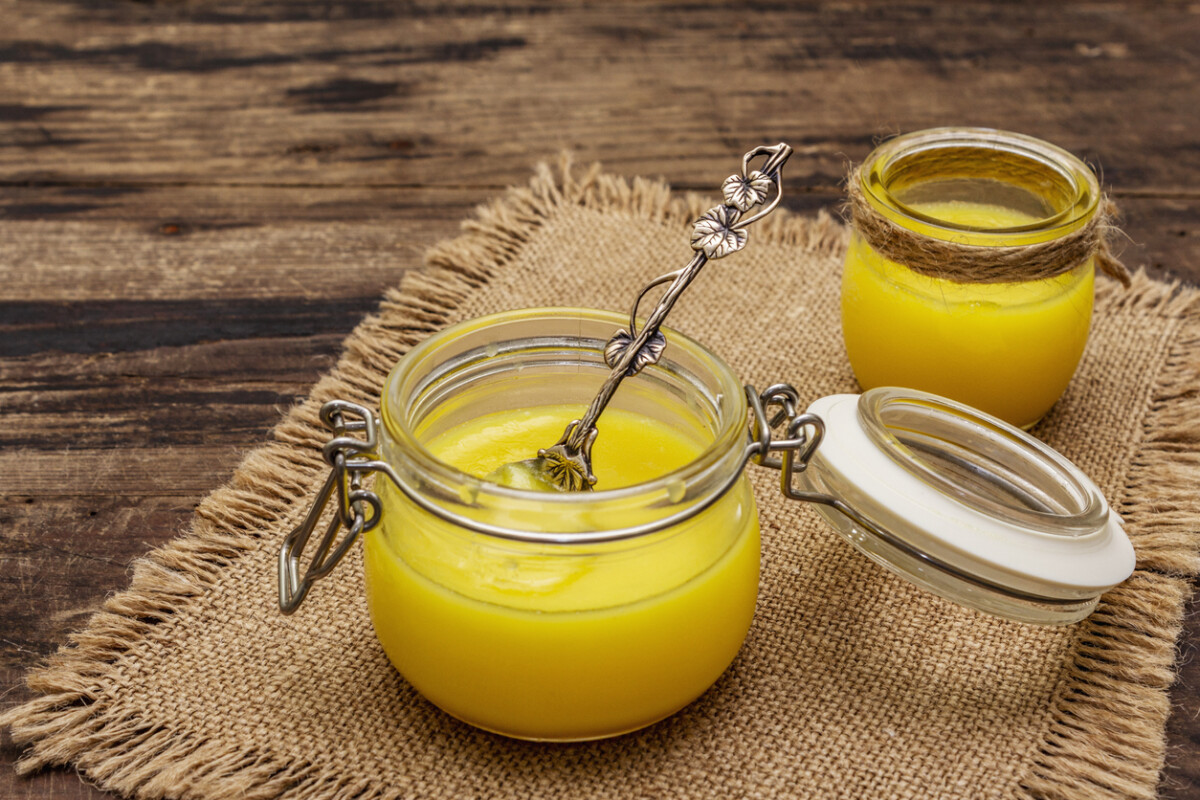
Pure Desi Ghee – Mediterranean’s treasured fat.
8- Olive Oil: Liquid Gold of the Mediterranean
Whenever I’m making rice or cooking grains like bulgur and freekeh, I find the harmonious combination of olive oil and ghee indispensable. The heartbeats of Mediterranean kitchens are intertwined with these liquids. They aren’t just cooking fats; they’re tradition, flavor, and essence all bottled up.
Olive Oil:
Olive oil is more than just a cooking medium in the Mediterranean – it’s a cultural icon. Its fruity, sometimes peppery taste enhances dishes, whether drizzling it over a Greek salad or using it as the base for an Italian pasta sauce. Moreover, olive oil is celebrated for its numerous health benefits. It is packed with monounsaturated fats and antioxidants and is known to reduce heart disease risks and promote overall well-being. When purchasing, look for extra virgin olive oil, the purest form, cold-pressed without heat or chemicals. For a deeper dive into the importance of olive oil and its role in the Mediterranean diet, check out my detailed blog post.
Pro Tip: Olive oil has a relatively low smoke point compared to other oils, making it unsuitable for high-temperature frying. But its flavor shines when used in sautéing, dressings, or simply drizzled over dishes.
Ghee:
Ghee, or clarified butter, has a rich history in Mediterranean and Middle Eastern cuisines. Its warm, nutty profile can be found gracing dishes from Lebanon to India, underlining the global appreciation of this golden liquid. Unlike regular butter, ghee is simmered to remove water and milk solids, leaving behind a clear, golden fat with a nutty aroma. This process gives ghee a higher smoke point, making it ideal for frying or high-heat cooking. If you’re curious about making your ghee, visit my blog on how to craft ghee at home.
Pro Tip: While ghee imparts a unique richness to dishes, it’s potent, so a little goes a long way. Use it to fry spices for a richer flavor or melt over flatbreads for an indulgent touch.
Incorporating these two fats into your cooking isn’t just about preparing food; it’s about embracing a millennia-old tradition that celebrates life’s simple pleasures.
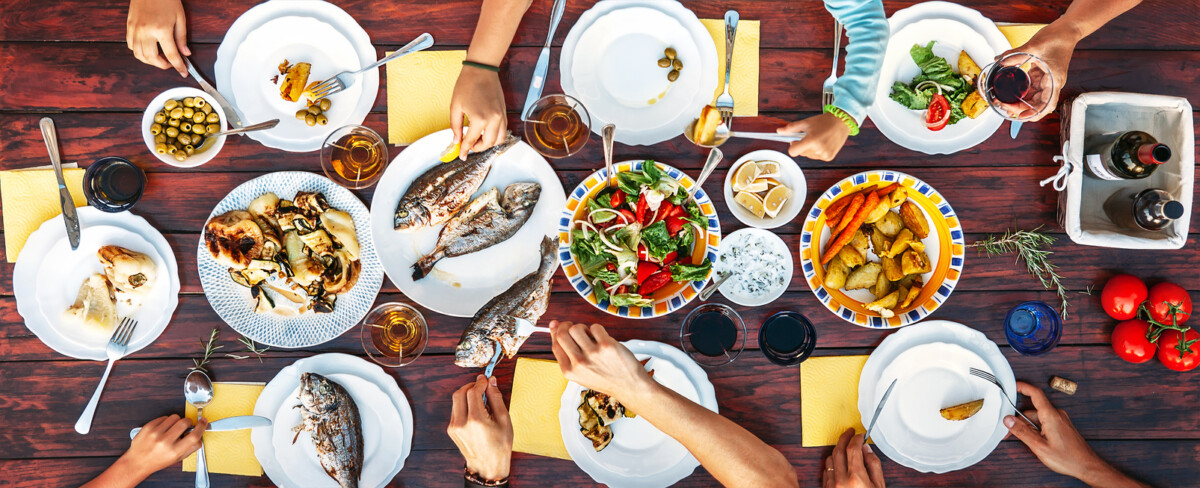
We are sharing meals, sharing moments.
Embracing the Heart of Mediterranean Cooking
As we conclude our exploration of Mediterranean cooking techniques, I encourage you to embrace the journey wholeheartedly. Dive deep into the traditions and practices that have shaped this region’s culinary tapestry. There’s unparalleled joy in experiencing the gentle simmer of a pot, the artful char of a grill, or mastering the intricate Mediterranean cooking techniques that balance flavors so exquisitely.
Remember, at the heart of these techniques is a principle of simplicity. It emphasizes fresh, quality ingredients that not only nourish but also champion health and longevity. While mastering these dishes is a reward, the true essence of Mediterranean cooking techniques shines brightest when the fruits of your labor are shared around a table, basking in the warmth of loved ones.
Embark on this Mediterranean culinary adventure with passion and curiosity. Relish the process, honor the heritage, and most importantly, treasure every shared bite with those you hold dear.



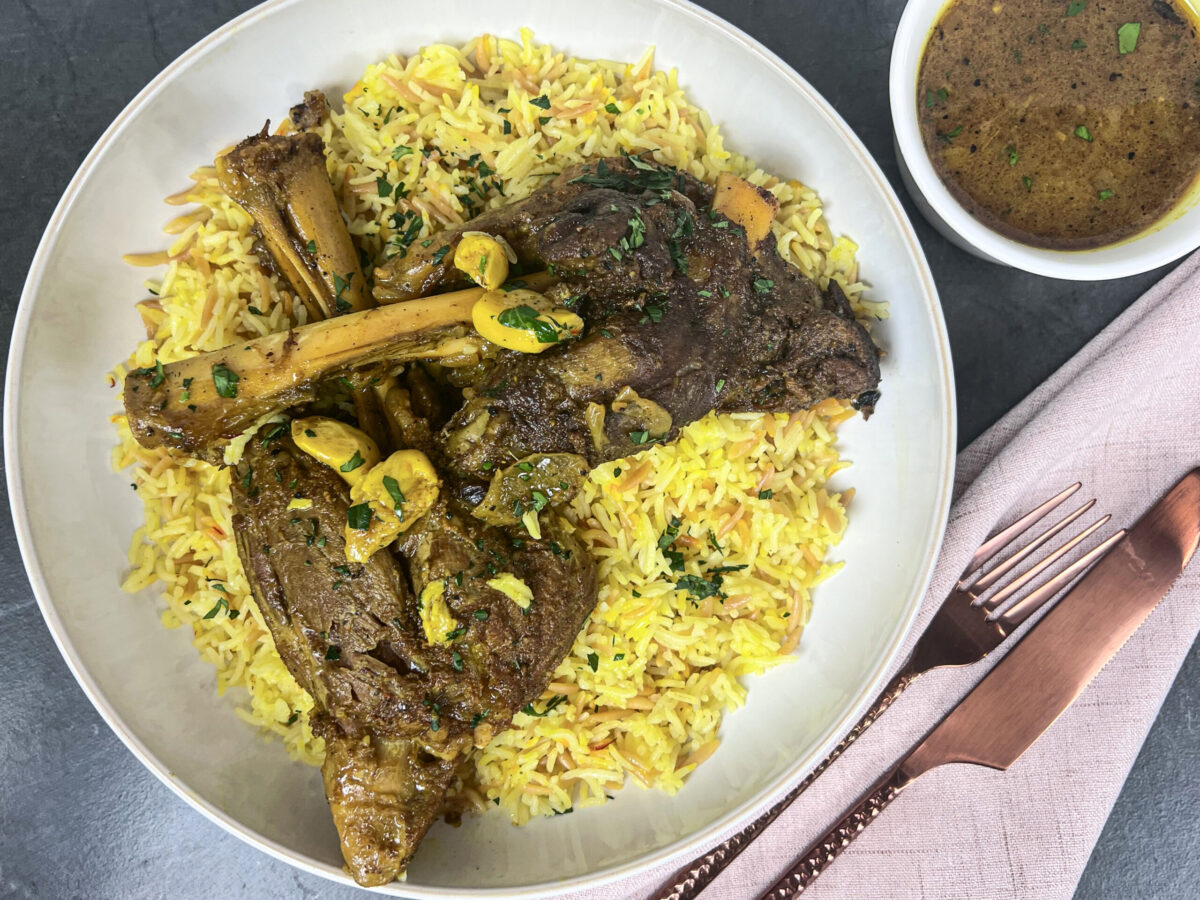




Leave a Reply